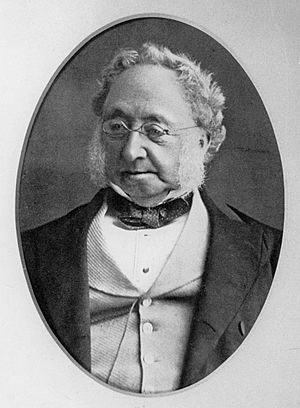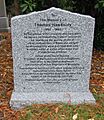Thomas Hawksley facts for kids
Quick facts for kids
Thomas Hawksley
|
|
|---|---|

Thomas Hawksley
|
|
| Born | 12 July 1807 Arnold, Nottinghamshire
|
| Died | 23 September 1893 (aged 86) Kensington, London
|
| Nationality | English |
| Education | Self-taught from age 15 |
| Occupation | Engineer |
| Children | Charles Hawksley |
| Parent(s) | John Hawksley and Sarah Thompson |
| Engineering career | |
| Discipline | Civil engineering |
| Institutions | Institution of Civil Engineers (president), Institution of Gas Engineers and Managers (president), Fellow of the Royal Society |
| Projects | Lindley Wood, Swinsty and Fewston reservoirs |
Thomas Hawksley (born 1807, died 1893) was an important English civil engineer. He lived in the 1800s and was famous for his work with water supply and coal gas systems. A civil engineer designs and builds things like roads, bridges, canals, and water systems.
Hawksley was one of the best water engineers in Britain during his time. He designed over 150 water supply projects. These projects helped bring clean water to many towns and cities.
Contents
Who Was Thomas Hawksley?
Thomas Hawksley was born on July 12, 1807. His family lived in Arnot Hill House, near Nottingham. His parents were John Hawksley and Sarah Thompson.
He went to Nottingham High School. But he mostly taught himself engineering from age 15. He learned a lot while working for an architecture firm. This firm also worked on projects related to water.
Early Work in Nottingham
Hawksley became the engineer for the Nottingham Gas Light and Coke Company. He also worked for the Nottingham Waterworks Company for over 50 years.
One of his first big projects was the Trent Bridge waterworks in 1831. This system was special because it provided a "constant supply" of water. This meant clean water was always flowing in the pipes. It also stopped dirty water from getting into the clean water supply.
Helping Towns Get Clean Water
Thomas Hawksley became well-known in 1844. This was during a time when people were looking into the health of towns. He strongly believed that people should have a constant supply of clean water. This idea made him very popular.
He worked on many major water projects across England. These included systems for cities like Liverpool, Sheffield, Leicester, and Leeds. He also designed drainage systems for places like Birmingham and Windsor. Drainage systems help remove wastewater from cities.
Hawksley's Engineering Practice
In 1852, Hawksley started his own engineering business. It was located in Westminster, London. He was a leader in his field.
He became the first president of the Institution of Gas Engineers and Managers in 1863. He was also a member of the Royal Society. In 1871, he was chosen as the President of the Institution of Civil Engineers. His son, Charles Hawksley, later became president of this same institution in 1901.
Important Reservoir Projects
Between 1869 and 1879, Hawksley helped build three important reservoirs. These were Lindley Wood, Swinsty, and Fewston. They were built for the Leeds Waterworks Company.
He also used a new method called "pressure grouting" in 1876 and 1877. He used it at the Tunstall and Cowm Reservoirs. This method helps stop water from leaking under a dam. It's a very important invention for building dams, even today.
Thomas Hawksley's Legacy
Thomas Hawksley passed away in Kensington, London, in 1893. He is buried in his family plot at Brookwood Cemetery in Surrey. In 2007, a special stone was placed on his grave.
He was the first of four generations of famous water engineers in his family. His son, Charles, his grandson, Kenneth, and his great-grandson, Thomas Edwin, all followed in his footsteps.
Today, the Institution of Mechanical Engineers still holds a yearly lecture in his honor. In 2023, a memorial was placed for him at Rivington. It honors his work on the Rivington Reservoir System.
Images for kids


